应用化学专业英语第二版万有志主编版(课后答案和课文翻译)
- 格式:doc
- 大小:311.00 KB
- 文档页数:37
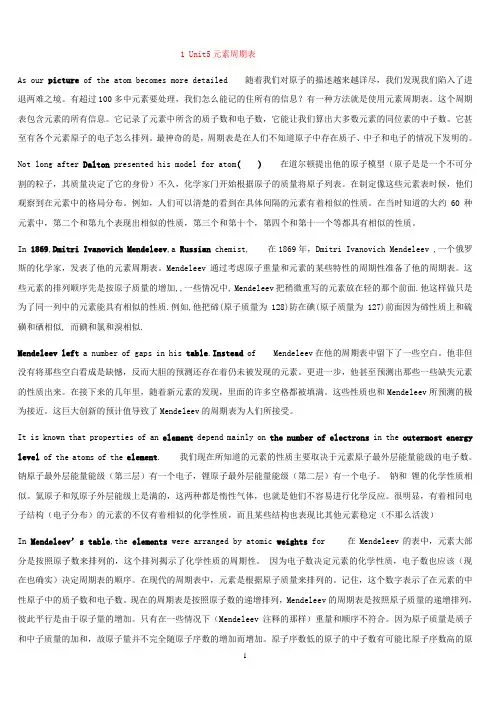
1 Unit5元素周期表As our picture of the atom becomes more detailed 随着我们对原子的描述越来越详尽,我们发现我们陷入了进退两难之境。
有超过100多中元素要处理,我们怎么能记的住所有的信息?有一种方法就是使用元素周期表。
这个周期表包含元素的所有信息。
它记录了元素中所含的质子数和电子数,它能让我们算出大多数元素的同位素的中子数。
它甚至有各个元素原子的电子怎么排列。
最神奇的是,周期表是在人们不知道原子中存在质子、中子和电子的情况下发明的。
Not long after Dalton presented his model for atom( )在道尔顿提出他的原子模型(原子是是一个不可分割的粒子,其质量决定了它的身份)不久,化学家门开始根据原子的质量将原子列表。
在制定像这些元素表时候,他们观察到在元素中的格局分布。
例如,人们可以清楚的看到在具体间隔的元素有着相似的性质。
在当时知道的大约60种元素中,第二个和第九个表现出相似的性质,第三个和第十个,第四个和第十一个等都具有相似的性质。
In 1869,Dmitri Ivanovich Mendeleev,a Russian chemist, 在1869年,Dmitri Ivanovich Mendeleev ,一个俄罗斯的化学家,发表了他的元素周期表。
Mendeleev通过考虑原子重量和元素的某些特性的周期性准备了他的周期表。
这些元素的排列顺序先是按原子质量的增加,,一些情况中, Mendeleev把稍微重写的元素放在轻的那个前面.他这样做只是为了同一列中的元素能具有相似的性质.例如,他把碲(原子质量为128)防在碘(原子质量为127)前面因为碲性质上和硫磺和硒相似, 而碘和氯和溴相似.Mendeleev left a number of gaps in his table.Instead of Mendeleev在他的周期表中留下了一些空白。
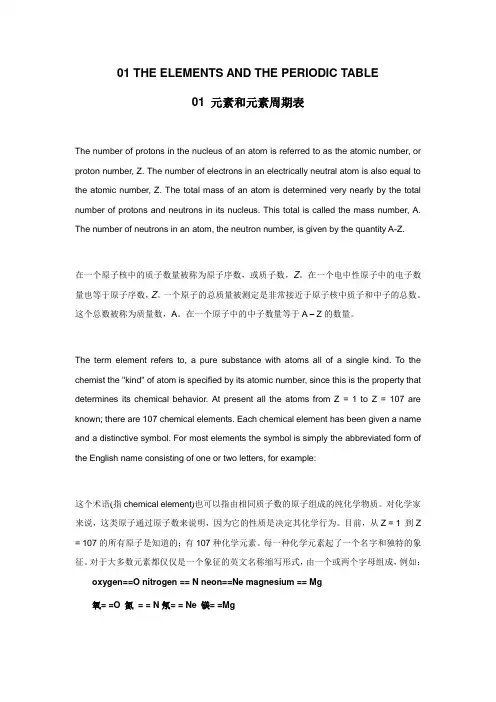
01 THE ELEMENTS AND THE PERIODIC TABLE01 元素和元素周期表The number of protons in the nucleus of an atom is referred to as the atomic number, or proton number, Z. The number of electrons in an electrically neutral atom is also equal to the atomic number, Z. The total mass of an atom is determined very nearly by the total number of protons and neutrons in its nucleus. This total is called the mass number, A. The number of neutrons in an atom, the neutron number, is given by the quantity A-Z.在一个原子核中的质子数量被称为原子序数,或质子数,Z。
在一个电中性原子中的电子数量也等于原子序数,Z。
一个原子的总质量被测定是非常接近于原子核中质子和中子的总数。
这个总数被称为质量数,A。
在一个原子中的中子数量等于A – Z的数量。
The term element refers to, a pure substance with atoms all of a single kind. To the chemist the "kind" of atom is specified by its atomic number, since this is the property that determines its chemical behavior. At present all the atoms from Z = 1 to Z = 107 are known; there are 107 chemical elements. Each chemical element has been given a name and a distinctive symbol. For most elements the symbol is simply the abbreviated form of the English name consisting of one or two letters, for example:这个术语(指chemical element)也可以指由相同质子数的原子组成的纯化学物质。
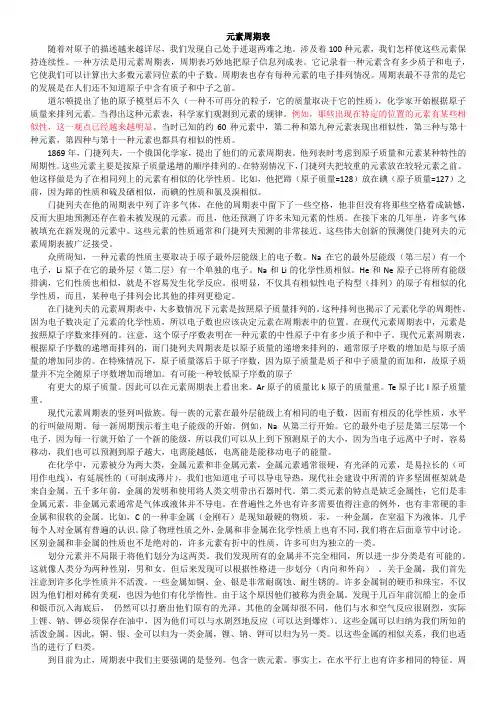
元素周期表随着对原子的描述越来越详尽,我们发现自己处于进退两难之地。
涉及着100种元素,我们怎样使这些元素保持连续性。
一种方法是用元素周期表,周期表巧妙地把原子信息列成表。
它记录着一种元素含有多少质子和电子,它使我们可以计算出大多数元素同位素的中子数。
周期表也存有每种元素的电子排列情况。
周期表最不寻常的是它的发展是在人们还不知道原子中含有质子和中子之前。
道尔顿提出了他的原子模型后不久(一种不可再分的粒子,它的质量取决于它的性质),化学家开始根据原子质量来排列元素。
当得出这种元素表,科学家们观测到元素的规律。
例如,那些出现在特定的位置的元素有某些相似性,这一观点已经越来越明显。
当时已知的约60种元素中,第二种和第九种元素表现出相似性,第三种与第十种元素,第四种与第十一种元素也都具有相似的性质。
1869年,门捷列夫,一个俄国化学家,提出了他们的元素周期表。
他列表时考虑到原子质量和元素某种特性的周期性。
这些元素主要是按原子质量递增的顺序排列的。
在特别情况下,门捷列夫把较重的元素放在较轻元素之前。
他这样做是为了在相同列上的元素有相似的化学性质。
比如,他把蹄(原子质量=128)放在碘(原子质量=127)之前,因为蹄的性质和硫及硒相似,而碘的性质和氯及溴相似。
门捷列夫在他的周期表中列了许多气体,在他的周期表中留下了一些空格,他非但没有将那些空格看成缺憾,反而大胆地预测还存在着未被发现的元素。
而且,他还预测了许多未知元素的性质。
在接下来的几年里,许多气体被填充在新发现的元素中。
这些元素的性质通常和门捷列夫预测的非常接近。
这些伟大创新的预测使门捷列夫的元素周期表被广泛接受。
众所周知,一种元素的性质主要取决于原子最外层能级上的电子数。
Na在它的最外层能级(第三层)有一个电子,Li原子在它的最外层(第二层)有一个单独的电子。
Na和Li的化学性质相似。
He和Ne原子已将所有能级排满,它们性质也相似,就是不容易发生化学反应。

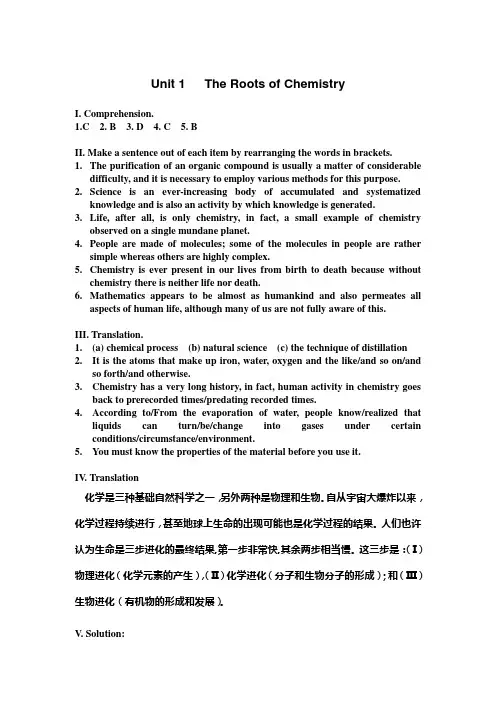
Unit 1 The Roots of ChemistryI. Comprehension.1.C2. B3. D4. C5. BII. Make a sentence out of each item by rearranging the words in brackets.1.The purification of an organic compound is usually a matter of considerabledifficulty, and it is necessary to employ various methods for this purpose.2.Science is an ever-increasing body of accumulated and systematizedknowledge and is also an activity by which knowledge is generated.3.Life, after all, is only chemistry, in fact, a small example of chemistryobserved on a single mundane planet.4.People are made of molecules; some of the molecules in people are rathersimple whereas others are highly complex.5.Chemistry is ever present in our lives from birth to death because withoutchemistry there is neither life nor death.6.Mathematics appears to be almost as humankind and also permeates allaspects of human life, although many of us are not fully aware of this.III. Translation.1.(a) chemical process (b) natural science (c) the technique of distillation2.It is the atoms that make up iron, water, oxygen and the like/and so on/andso forth/and otherwise.3.Chemistry has a very long history, in fact, human activity in chemistry goesback to prerecorded times/predating recorded times.4.According to/From the evaporation of water, people know/realized thatliquids can turn/be/change into gases under certain conditions/circumstance/environment.5.You must know the properties of the material before you use it.IV. Translation化学是三种基础自然科学之一,另外两种是物理和生物。

应用化学专业英语翻译完整篇应用化学专业英语翻译完整篇1 Unit5元素周期表As our picture of the atom becomes more detailed 随着我们对原子的描述越来越详尽,我们发现我们陷入了进退两难之境。
有超过100多中元素要处理,我们怎么能记的住所有的信息?有一种方法就是使用元素周期表。
这个周期表包含元素的所有信息。
它记录了元素中所含的质子数和电子数,它能让我们算出大多数元素的同位素的中子数。
它甚至有各个元素原子的电子怎么排列。
最神奇的是,周期表是在人们不知道原子中存在质子、中子和电子的情况下发明的。
Not long after Dalton presented his model for atom( ) 在道尔顿提出他的原子模型(原子是是一个不可分割的粒子,其质量决定了它的身份)不久,化学家门开始根据原子的质量将原子列表。
在制定像这些元素表时候,他们观察到在元素中的格局分布。
例如,人们可以清楚的看到在具体间隔的元素有着相似的性质。
在当时知道的大约60种元素中,第二个和第九个表现出相似的性质,第三个和第十个,第四个和第十一个等都具有相似的性质。
In 1869,Dmitri Ivanovich Mendeleev,a Russian chemist, 在1869年,Dmitri Ivanovich Mendeleev ,一个俄罗斯的化学家,发表了他的元素周期表。
Mendeleev通过考虑原子重量和元素的某些特性的周期性准备了他的周期表。
这些元素的排列顺序先是按原子质量的增加,,一些情况中, Mendeleev把稍微重写的元素放在轻的那个前面.他这样做只是为了同一列中的元素能具有相似的性质.例如,他把碲(原子质量为128)防在碘(原子质量为127)前面因为碲性质上和硫磺和硒相似, 而碘和氯和溴相似.Mendeleev left a number of gaps in his table.Instead of Mendeleev在他的周期表中留下了一些空白。
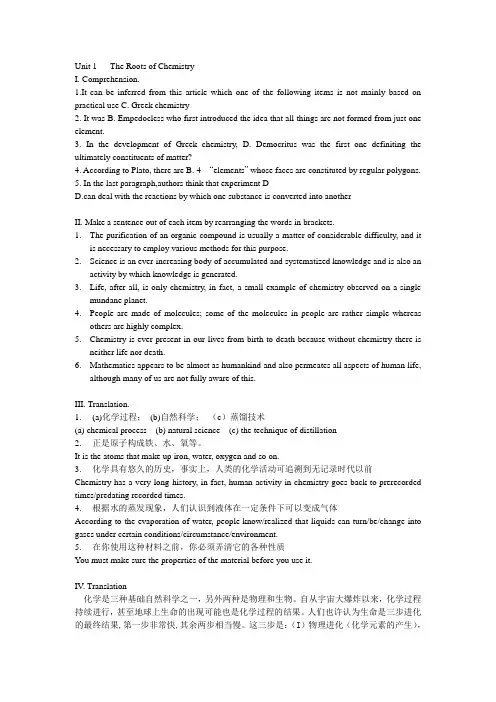
Unit 1 The Roots of ChemistryI. Comprehension.1.It can be inferred from this article which one of the following items is not mainly based on practical use C. Greek chemistry2. It was B. Empedocless who first introduced the idea that all things are not formed from just one element.3. In the development of Greek chemistry, D. Democritus was the first one definiting the ultimately constituents of matter?4. According to Plato, there are B. 4 ―elements‖ whose faces are constituted by regular polygons.5. In the last paragraph,authors think that experiment DD.can deal with the reactions by which one substance is converted into anotherII. Make a sentence out of each item by rearranging the words in brackets.1.The purification of an organic compound is usually a matter of considerable difficulty, and itis necessary to employ various methods for this purpose.2.Science is an ever-increasing body of accumulated and systematized knowledge and is also anactivity by which knowledge is generated.3.Life, after all, is only chemistry, in fact, a small example of chemistry observed on a singlemundane planet.4.People are made of molecules; some of the molecules in people are rather simple whereasothers are highly complex.5.Chemistry is ever present in our lives from birth to death because without chemistry there isneither life nor death.6.Mathematics appears to be almost as humankind and also permeates all aspects of human life,although many of us are not fully aware of this.III. Translation.1.(a)化学过程;(b)自然科学;(c)蒸馏技术(a) chemical process (b) natural science (c) the technique of distillation2.正是原子构成铁、水、氧等。

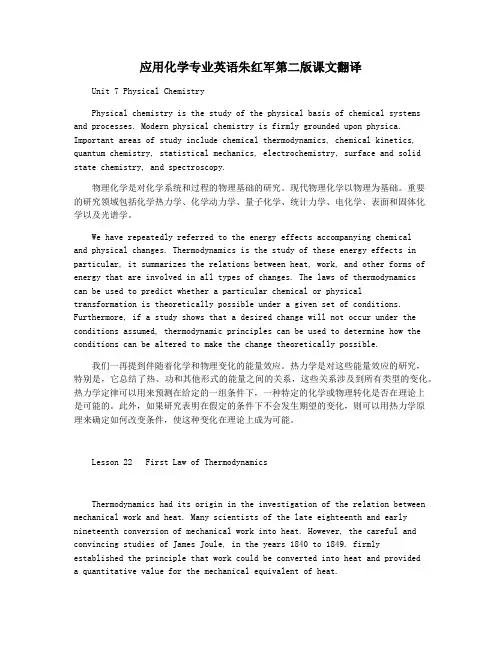
应用化学专业英语朱红军第二版课文翻译Unit 7 Physical ChemistryPhysical chemistry is the study of the physical basis of chemical systems and processes. Modern physical chemistry is firmly grounded upon physica. Important areas of study include chemical thermodynamics, chemical kinetics, quantum chemistry, statistical mechanics, electrochemistry, surface and solid state chemistry, and spectroscopy.物理化学是对化学系统和过程的物理基础的研究。
现代物理化学以物理为基础。
重要的研究领域包括化学热力学、化学动力学、量子化学、统计力学、电化学、表面和固体化学以及光谱学。
We have repeatedly referred to the energy effects accompanying chemicaland physical changes. Thermodynamics is the study of these energy effects in particular, it summarizes the relations between heat, work, and other forms of energy that are involved in all types of changes. The laws of thermodynamics can be used to predict whether a particular chemical or physicaltransformation is theoretically possible under a given set of conditions. Furthermore, if a study shows that a desired change will not occur under the conditions assumed, thermodynamic principles can be used to determine how the conditions can be altered to make the change theoretically possible.我们一再提到伴随着化学和物理变化的能量效应。
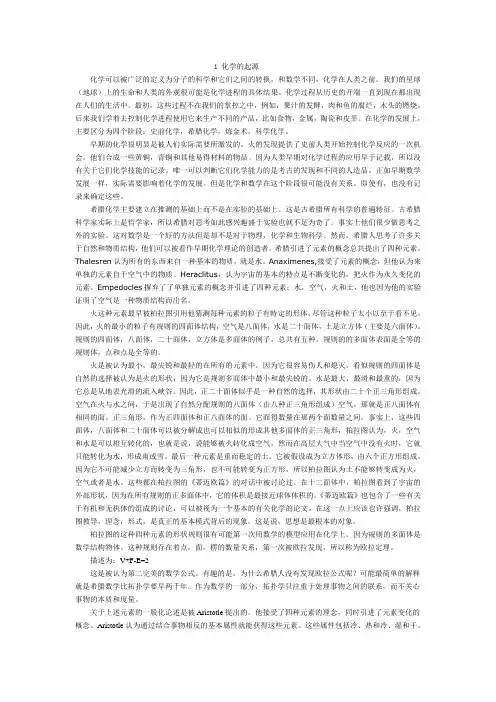
1化学的起源化学可以被广泛的定义为分子的科学和它们之间的转换。
和数学不同,化学在人类之前。
我们的星球(地球)上的生命和人类的外观很可能是化学进程的具体结果。
化学过程从历史的开端一直到现在都出现在人们的生活中。
最初,这些过程不在我们的掌控之中,例如,果汁的发酵,肉和鱼的腐烂,木头的燃烧。
后来我们学着去控制化学进程使用它来生产不同的产品,比如食物,金属,陶瓷和皮革。
在化学的发展上,主要区分为四个阶段:史前化学,希腊化学,炼金术,科学化学。
早期的化学很明显是被人们实际需要所激发的。
火的发现提供了史前人类开始控制化学反应的一次机会。
他们合成一些黄铜,青铜和其他易得材料的物品。
因为人类早期对化学过程的应用早于记载,所以没有关于它们化学技能的记录。
唯一可以判断它们化学能力的是考古的发现和不同的人造品。
正如早期数学发展一样,实际需要影响着化学的发展。
但是化学和数学在这个阶段很可能没有关系。
即使有,也没有记录来确定这些。
希腊化学主要建立在推测的基础上而不是在实验的基础上。
这是古希腊所有科学的普遍特征。
古希腊科学家实际上是哲学家,所以希腊对思考如此感兴趣盛于实验也就不足为奇了。
事实上他们很少做思考之外的实验。
这对数学是一个好的方法但是却不是对于物理,化学和生物科学。
然而,希腊人思考了许多关于自然和物质结构,他们可以被看作早期化学理论的创造者。
希腊引进了元素的概念总共提出了四种元素。
Thalesren认为所有的东西来自一种基本的物质,就是水。
Anaximenes,接受了元素的概念,但他认为来单独的元素自于空气中的物质。
Heraclitus,认为宇宙的基本的特点是不断变化的,把火作为永久变化的元素。
Empedocles摒弃了了单独元素的概念并引进了四种元素:水,空气,火和土,他也因为他的实验证明了空气是一种物质结构而出名。
火这种元素最早被柏拉图引用他猜测每种元素的粒子有特定的形体,尽管这种粒子太小以至于看不见。
因此,火的最小的粒子有规则的四面体结构,空气是八面体,水是二十面体,土是立方体(主要是六面体)。
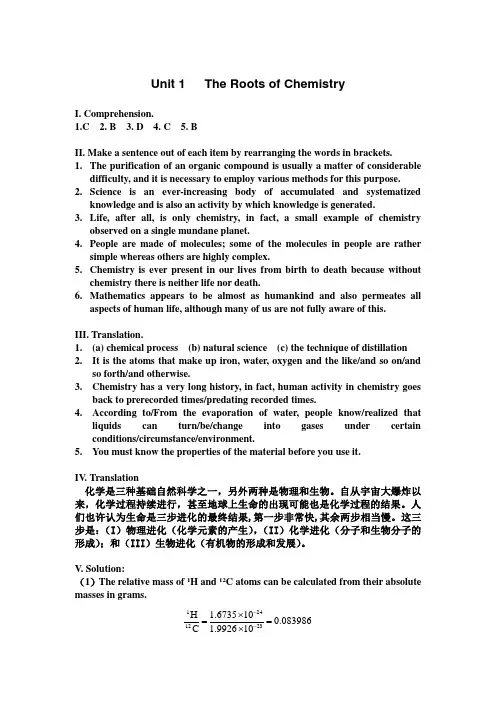
Unit 1 The Roots of ChemistryI. Comprehension.1.C2. B3. D4. C5. BII. Make a sentence out of each item by rearranging the words in brackets.1. The purification of an organic compound is usually a matter of considerable difficulty, and it is necessary to employ various methods for this purpose.2. Science is an ever-increasing body of accumulated and systematized knowledge and is also an activity by which knowledge is generated.3. Life, after all, is only chemistry, in fact, a small example of chemistry observed on a single mundane planet.4. People are made of molecules; some of the molecules in people are rather simple whereas others are highly complex.5. Chemistry is ever present in our lives from birth to death because without chemistry there is neither life nor death.6. Mathematics appears to be almost as humankind and also permeates all aspects of human life, although many of us are not fully aware of this.III. Translation.1. (a) chemical process (b) natural science (c) the technique of distillation2. It is the atoms that make up iron, water, oxygen and the like/and so on/andso forth/and otherwise.3. Chemistry has a very long history, in fact, human activity in chemistry goesback to prerecorded times/predating recorded times.4. According to/From the evaporation of water, people know/realized thatliquids can turn/be/change into gases under certain conditions/circumstance/environment.5. You must know the properties of the material before you use it.IV . Translation化学是三种基础自然科学之一,另外两种是物理和生物。
应用化学专业英语1单元翻译第一篇:应用化学专业英语1单元翻译1.Chemistry can be broadly defines as the science of molecules and their transformations.化学可以广泛地定义为科学的分子和他们的转换。
化学可以广泛地定义为科学的分子和他们的转换。
与数学不同,化学比人类更久远。
生命的出现和人类生活在我们地球上都最可能是特殊化学过程的结果。
化学过程存从古至今存在人们的生活中。
•最初,这些过程不受我们的控制,例如,果汁的发酵,肉和鱼的腐烂,木材的燃烧。
后来,我们学着控制化学过程,用它们来准备一系列不同的产品例如食物。
在化学的发展中,四个阶段是突出的:史前化学,希腊化学,炼金术和科学化学。
The early beginnings of chemistry were clearly motivated by practical needs of people.早期的化学显然是出于实际的需要。
火的发现为远古人提供了第一个机会去实现控制化学反应过程。
他们学会制备铜制物品,铜和其它材料是现成的。
.由于化学过程的使用早于人们的书写,因而没有书面记录有关它们的化学技巧。
可以判断他们的化学能力只有从考古的发现的各个手工艺品。
正如早期的数学发展,清楚的预示着实际需求影响着化学的发展。
但化学和数学在这个阶段可能没有互相影响。
如果它们影响了,但是没有记录证明这个。
Greek chemistry was based mainly on speculation rather than on experiment.希腊化学主要基于猜测而不是实验。
这是所有古代希腊化学的一个共同特征。
古代希腊化学家实际是希腊哲学家。
所以不足为奇的是希腊人思考比实验更有兴趣。
实际上他们很少进行实验以外的思维实验。
对于数学来说这是一个好方法,但没有一个人把它推荐在物理、化学或生物科学上。
应用化学专业英语第二版万有志主编版(课后答案和课文翻译)If the mass of a 12C atom is exactly 12 amu,then the mass of a 1H atom to five significant figures must be 1.0078 amu. 12 amu x 0.083986 = 1.0078 amu(2)First we calculate k and then use the first-order rate equation.[][]()()404340.6931.2110/5730log2.3031.000 1.2110/log0.477 2.3032.303log 2.09 6.11061001.2110/k yryrA ktA yrt t yr yr---==⨯=⨯===⨯=⨯The bone was tossed away (more precisely, the animal whose bone was died) about 6100 years ago, or about 4100 B.C. We can thus be sure that a village was in existence at that place at that time.Unit 7 The Nomenclature of Inorganic SubstancesI. Comprehension1.A2.B3.C4.C5.BII. Give the systematic name for the followingammonium ion ; copper(II) ion ; strontium ion; Ccopper(I) ion; iron(II) ion; zinc ion; hydrogen ion; lead((II) ion; aluminum;silver ion; magnesium ion; chromium(III) ion; Barium ; Manganese(II) ion; iron(III) ion; calcium ion; mercury(II) ion; chromium(II) ion; tin(II) ion.carbon monoxide; ditrogen trioxide; carbon dioxide; diphosphorus pentoxide; sulfur trioxide; dichlorine heptoxidearsenate ion; sulfite ion; hydride ion; arsenite ion; bromide ion; hydroxide ion; phosphate ion; chlorate ion; hypochlorite ion; phosphate ion; chloride ion; iodate ion; carbonate ion; chlorite ion; nitrate ion;chromate ion; cyanide ion; iodide ion;dichromate ion; fluoride ion; nitrate ion;oxide ion; hydrogen carbonate ion; nitrite ion;sulfide ion; hydrogen sulfate ion; perchlorate ion;sulfate ion; hydrogen sulfite ion; permanganate ion.III. Complete the table.Formula Old name SystematicnameFeO iron (II) oxide Fe2O3iron (III) oxide Sn(OH)2tin(II)hydroxideSn(OH)4tin(IV)hydroxideHg2SO4mercury (I)sulfateHgSO4mercury (II)sulfate NaCLO sodiumhypochloriteK2Cr2O7potassiumdichromateCu3(AsO4)2copper(II)arsenateCr(C 2H 3O 2)3 chromium(IV) acetateIV . Acid names may be obtained directly from its acid ion by changing the name of the acid ion (negative ion). Use the rule to give the name of the following acid. Formula of acid Old name Name of acid H 2CO 3 carbonic acid HClO 2 chlorous acid HClO 4 perchloric acid HCN hydrocyanic acid HBr hydrobromic acid H 4SiO 4 silicic acid H 3AsO 4 arsenic acid V . Complete the sentences with the proper form of the word given at the end of the sentence.1.is altered;2.To illustrate3.indicates4.should expect5.would cancel6. are pulled7.depend on8.are; referred9.formed 10.have discussed VI. Translation1. Matter can neither be created nor be destroyed/eliminated.2. It is necessary that a scientist must know how to use fingures to get an accutate answer to question.3. Any substance is made of atoms whether it is solid, liquid or gas.4. The experiment was successful. It ’s results was the same as what we had expected.5. It will not be long before we finish the experiment.VII. Write equations for the following acid-base reactions. Use the information in inorganic textbook to predict whether the equilibrium will favor the reactants or the products. (Partially Solved)Solutin to (a): Cyanide is the conjugate base of HCN. It can accept a proton from formic acid:COHHO +CN C OH OC NH +formic acid stronger acid cyanidestronger base formate weaker baseweaker acidReading from inorganic textbook, formic acid (p K a =3.76) is a stronger acid than HCN (p K a =9.22), and cyanide is a stronger base than formate. The products (weaker acid and base) are favored. …………..VIII. Write equations for the net reactions which occur when the following materials are added to a sodium-ammonia solution.Answer: (1) 2CH3GeH3 + 2e am-→ H2 + 2CH3GeH2-(2) I2 + 2e am-→ 2I-(3) (C2H5)2S + 2e am- + NH3 → C2H5S- + C2H6 + NH2-Unit 10 Nomenclature of HydrocarbonsI. Comprehension1.C2.D3.B4.A5.B6.BII. Name the following compounds by the IUPAC system1 CH3(CH2)nCH3 (n=2, 3, 4, 6, respectively) butane, pentane, hexane,octane2 (CH3)2-CH2-CH2-CH2-CH32-methylpentane3 (CH3)3C-CH2-CH(C2H5)-CH2-CH34-ethyl-2,2-dimethylhexane5-isopropyl-2-methyloctane4 (CH3)2CH-CH2CH2-CH(CH2CH2CH3)-CH(CH3)24-isopropyl-4-propylheptane 5 CH3-CH2-CH2-C(CH2CH2CH3)2-CH(CH3)26 ◇-CH2-CH(CH3)2isobutylcyclobutane7 CH2=C(C2H5)(CH(CH3)2) 2-ethyl-3-methyl-1-butene8 CH3-CH2-CH=CH-CHCl-CH32-chloro-3-hexene9 CH3-CH(CH3)-CH(C2H5)-C≡C-CH34-ethyl-5-methyl-2-hexyneCH2=CH-C≡CH 1-buten-3-yne11(CH3)2CH-CH2CH(OH)CH34-methyl-2-pentanol12CH3CH2CH=CHCH(OH)CH33-hexen-2-ol13(CH3)3C-OH 2-methyl-2-propanol14(CH3)3C-OCH2H52-ethoxy-2-methylpropane15(CH3)2CH-CH2-O-C2H51-ethoxy-2-methylpropane16(CH2OH)21,2-ethanediol17CH3-CH(OH)-CH2(OH) 1,2-proanediol18CH2(OH)-CH(OH)-CH2(OH) 1,2,3-propanetriol19CH3CH2NH2aminoethane2 0 CH3CH2CH2CH(CH3)CH-NH-CH3N-methyl-1-amino-2-methylpentaneIII. Draw structures for the following compounds.1 3-octene C-C-C=C-C-C-C-C2 3-methy-2-heptene3 cyclohexene4 2-pentyne C-C≡C-C-C5 3,3-dimethylhexyne6 3-bromotolueneCH3Br7 vinyl chloride C=C-Cl8 acetylene C≡C9 para-dichlorobenzeneCl Cl10 m-chlorobromobenzeneBrCl11 toluene CH312 chlorobenzene Cl13 1,2-dibromobenzeneBrBr14 naphthalene15 anthracene16 phenanthrene17 2-methyl-1-propanol C CC OHC18 Cyclohexanol OH19 Methoxyethene C C O C20 trans-2-ethoxycyclohexanol OHOC2H5IV. Decide which item best completes each unfinished sentence.1.A2.A3.B4.CV. Each of the following names is incorrect. Draw the structure represented by the incorrect name (or a consistent structure if the name is ambiguous), and give your drawing the correct name.(…………)Unit 11 Carboxylic Acids and Their DerivativesI. Comprehension1.B2.B3.C4.D5.A6.CII. Fill in the blanks with the phrases given below.1.brought out2.dozen or so; put together3.are made of ;divided by4.are different from5.on the contrary; consist of6.summed up7.stand for8.such as9.are; dependent on 10.break down intoIII. Put in proper prepositions or adverbs into the blanks.1.with; as2.to3.about4.from5.intoIV. Translation1. Similarly, solvent also may not be liquid matter but the others2. A graph plotting solubility against temperature is called a solubility curve. ( The curve plot drawn (made / produced) by solubility as one coordinate and temperature as another coordinate is called solubility curve.)3. Air is mixture of gases , the most abundant of which is nitrogen in the form of N2 (molecules).4. The direction of the reaction and the position of the equilibrium may also be affected by the temperature, pressure, and other conditions.5. Hydrogen has a great affinity for oxygen and easily combines with it to form water.V. Translation玻意尔(Bohr)模型提出不久后,人们就发现原子中的电子比Bohr提出的模型要复杂得多。
Unit 1 Scientific Paper and LiteratureLesson 1Writing a Scientific Paper这一章节是写科学论文一个总的指导。
包括对于文章长度要求,数字和图标的制备,还有向不同杂志和出版商提交论文的说明指导方针。
对于美国化学学会杂志和特殊的出版物,请阅读出现在每年第一期和全球网上对于作者的指南,注释,公告和说明。
对于美国化学学会的书目,请查阅一些像《如何为ACS准备你的底稿》,《作者须知》这样的小册子,这些资料可以从书籍部或者在相同地址的全球网页上得到。
Introduction to Science Paper一篇研究论文是学术交流的书面形式,它可以用来传播有用的信息并且可以和别人分享有用的学术见解。
大多数的研究论文是用于杂志出版或者作为个人领域的会议记录。
出版史作为传播见解和专业认知与提高最快捷的方法。
如果你对学术文章的特点和形式有着清晰的认识,那么你的论文可以更容易的在目标杂志上发表或者被国际会议所采纳。
Features of Academic Papers 学术论文的特色学术论文的第一个特色就是内容。
它只不过是你做的部分研究客观并且准确的记录,要么是关于人文、社会、科学、自然科学或者应用科学。
它不能用来教授或者提供一般背景。
论文的第二个特征就是这一目的的写作方式。
你的论文必须包含三种要素:严格的逻辑结构,清晰和简洁的语言,还有就是你论文要提交的杂志所规定的特定写作形式。
第三,实际上是第二条的一部分,就是文章所用资源的引证系统。
在文章过程的每一步里,你必须对你从资源查阅到的想法、事实、观点进行充分考虑。
学术论文中的特征中最方便的地方之一是学术论文被清晰的分成几个部分。
这一点对你很有帮助,因为你每次只需考虑一个部分。
当你撰写其中一个部分时你总能总揽全文。
尽管人文科学和社会科学没有明显的界限,但是他们遵循科学论文的一般要求。
Getting Started尽管学术论文不想食谱配方或者实验流程一样有一套固定的写作规矩,但是一些指导方针也是很有帮助的。
Unit 1 The Rootsof Chemis tryI. Compre hensi on.1.It can be inferred from this articl e whichone of the followi ng itemsi s not mainly basedon practi c al use C. Greekchemis try2. It was B. Empedo cless who firsti ntrod ucedthe idea that all things are not formed from just one elemen t.3. In the develo pment of Greekchemis t ry, D. Democri tus was the first one defini tingthe ultimatelyconsti tuent s of matter?4. Accord i ng to Plato, thereare B. 4 ―elemen ts‖ whosefacesare consti tuted by regula r polygons.5. In the last paragraph,authors thinkthat experi ment DD.can deal with the reacti ons by whichone substa n ce is converted into anothe rII. Make a senten ce out of each item by rearra nging the wordsin bracke ts.1.The purifi catio n of an organi c compou nd is usuall y a matter of consid erabl e diffic ulty, and itis necess ary to employ variou s method s for this purpos e.2.Scienc e is an ever-increa singbody of accumu lated and system atize d knowle dge and is also anactivi ty by whichknowle dge is genera ted.3.Life, afterall, is only chemis try, in fact, a smallexampl e of chemis try observ ed on a si nglemundan e planet.4.People are made of molecul es; some of the molecul es in people are rather simple wherea sothers are highly comple x.5.Chemist ry is ever presen t in our livesfrom birthto deathbecause withou t chemis t ry therei sneithe r life nor death.6.Mathem atics appears to be almost as humanki nd and also permea tes all aspect s of humanlife,althou gh many of us are not fullyawareof this.III. Transl ation.1.(a)化学过程;(b)自然科学;(c)蒸馏技术(a) chemic al proces s (b) natura l science (c) the techni que of distil latio n2.正是原子构成铁、水、氧等。
应用化学专业英语第二版课后练习题含答案Chapter OneMultiple Choice Questions1.The scientific method of problem solving consists of___________. A. observation, experimentation, hypotheses, theory B.experimentation, observation, theory, hypotheses C. observation, hypotheses, theory, experimentation D. hypothesis, theory,experimentation, observationAnswer: A2.Which of the following is NOT one of the key steps involvedin the scientific method? A. Formulating hypotheses B. Building experiments C. Rejecting hypotheses D. Proving hypothesesAnswer: D3.Which of the following is a physical property? A. Density B.Flammability C. Reaction with acid D. RustingAnswer: A4.Which subatomic particle carries a positive charge? A.Proton B. Neutron C. Electron D. AtomAnswer: A5.Which of the following is NOT a chemical change? A. Burningof wood B. Digestion of food C. Melting of ice D. Rusting of ironAnswer: CShort Answer Questions1.What is the difference between a chemical and physicalchange? Answer: A physical change is a change in the physicalproperties of a substance, whereas a chemical change is a change in the chemical properties or composition of a substance.2.What is an atom? Answer: An atom is the smallest particle ofmatter that retns the chemical properties of an element.3.What is a molecule? Answer: A molecule is a group of two ormore atoms that are chemically bonded together.4.What is an element? Answer: An element is a pure substancethat cannot be broken down into simpler substances by chemical means.5.What is a compound? Answer: A compound is a pure substancemade up of two or more elements that are chemically bondedtogether.Essay Questions1.What is the scientific method and how is it used to solveproblems in science? Answer: The scientific method is a logical and systematic approach to problem solving in science. It consists of several key steps including observation, hypotheses,experimentation, and theory. Scientists use the scientific method to answer questions and solve problems by gathering data through observation and experimentation, forming hypotheses based on that data, testing those hypotheses through experimentation, andfinally developing theories to expln the results of those experiments.2.Describe the properties of matter and how they are used to differentiate between substances. Answer: Properties of matter can be either physical or chemical. Physical properties include mass, volume, density, color, melting point, boiling point, and solubility. These properties can be used to differentiate between substances by comparing their physical properties. Chemical properties include reactivity, flammability, and toxicity. These properties are used to differentiate between substances based on their chemical behavior under certn conditions.3.Describe the structure of an atom and the role that subatomic particles play in determining chemical behavior. Answer: Atoms have a central nucleus that contns protons and neutrons. Electrons orbit around the nucleus in shells or orbitals. Protons carry a positive charge, electrons carry a negative charge, and neutrons carry no charge. The number of protons in the nucleus determines the element to which the atom belongs, while the number of electrons in the outermost shell determines the chemical behavior of the atom.4.Expln the difference between a mixture and a pure substance. Give examples of each. Answer: A mixture is a combination of two or more substances that are not chemically bonded together. Mixtures can be either homogeneous or heterogeneous. A homogeneous mixture is a uniform mixture where the composition is the same throughout, such as saltwater. A heterogeneous mixture is a non-uniform mixture where the composition varies, such as oil and water. A pure substance is a substance that cannot be broken down into simpler substances by chemical means. Examples of pure substances include elements such as gold and silver, and compounds such as water and carbon dioxide.5.Expln the difference between a physical change and a chemical change. Give examples of each. Answer: A physical change is a change in the physical properties of a substance, such as shape, size, or state of matter, without changing its chemical composition. Examples of physical changes include melting ice, boiling water, and cutting paper. A chemical change is a change in the chemical properties or composition of a substance, resulting in the formation of a new substance or substances. Examples of chemical changes include burning of wood, digestion of food, and rusting of iron.。
应用化学专业英语第二版万有志主编版(课后答案和课文翻译)Unit 1 The Roots of ChemistryI. Comprehension.1.C2. B3. D4. C5. BII. Make a sentence out of each item by rearranging the words in brackets.1. The purification of an organic compound is usually a matter of considerable difficulty, and it is necessary to employ various methods for this purpose.2. Science is an ever-increasing body of accumulated and systematized knowledge and is also an activity by which knowledge is generated.3. Life, after all, is only chemistry, in fact, a small example of chemistry observed on a single mundane planet.4. People are made of molecules; some of the molecules in people are rather simple whereas others are highly complex.5. Chemistry is ever present in our lives from birth to death because without chemistry there is neither life nor death.6. Mathematics appears to be almost as humankind and also permeates all aspects of human life, although many of us are not fully aware of this.III. Translation.1. (a) chemical process (b) natural science (c) the technique of distillation2. It is the atoms that make up iron, water, oxygen and the like/and so on/andso forth/and otherwise.3. Chemistry has a very long history, in fact, human activity in chemistry goesback to prerecorded times/predating recorded times.4. According to/From the evaporation of water, people know/realized thatliquids can turn/be/change into gases under certain conditions/circumstance/environment.5. You must know the properties of the material before you use it.IV . Translation化学是三种基础自然科学之一,另外两种是物理和生物。
自从宇宙大爆炸以来,化学过程持续进行,甚至地球上生命的出现可能也是化学过程的结果。
人们也许认为生命是三步进化的最终结果,第一步非常快,其余两步相当慢。
这三步是:(I )物理进化(化学元素的产生),(II )化学进化(分子和生物分子的形成);和(III )生物进化(有机物的形成和发展)。
V . Solution:(1)The relative mass of 1H and 12C atoms can be calculated from their absolute masses in grams.1241223H 1.6735100.083986C 1.992610--⨯==⨯If the mass of a 12C atom is exactly 12 amu,then the mass of a 1H atom to five significant figures must be 1.0078 amu. 12 amu x 0.083986 = 1.0078 amu(2)First we calculate k and then use the first-order rate equation.[][]()()404340.6931.2110/5730log2.3031.000 1.2110/log0.477 2.3032.303log 2.09 6.11061001.2110/k yryrA ktA yrt t yr yr---==⨯=⨯===⨯=⨯The bone was tossed away (more precisely, the animal whose bone was died) about 6100 years ago, or about 4100 B.C. We can thus be sure that a village was in existence at that place at that time.Unit 7 The Nomenclature of Inorganic SubstancesI. Comprehension1.A2.B3.C4.C5.BII. Give the systematic name for the followingammonium ion ; copper(II) ion ; strontium ion; Ccopper(I) ion; iron(II) ion; zinc ion; hydrogen ion; lead((II) ion; aluminum;silver ion; magnesium ion; chromium(III) ion; Barium ; Manganese(II) ion; iron(III) ion; calcium ion; mercury(II) ion; chromium(II) ion; tin(II) ion.carbon monoxide; ditrogen trioxide; carbon dioxide; diphosphorus pentoxide; sulfur trioxide; dichlorine heptoxidearsenate ion; sulfite ion; hydride ion; arsenite ion; bromide ion; hydroxide ion; phosphate ion; chlorate ion; hypochlorite ion; phosphate ion; chloride ion; iodate ion; carbonate ion; chlorite ion; nitrate ion;chromate ion; cyanide ion; iodide ion;dichromate ion; fluoride ion; nitrate ion;oxide ion; hydrogen carbonate ion; nitrite ion;sulfide ion; hydrogen sulfate ion; perchlorate ion;sulfate ion; hydrogen sulfite ion; permanganate ion.III. Complete the table.Formula Old name SystematicnameFeO iron (II) oxide Fe2O3iron (III) oxide Sn(OH)2tin(II)hydroxideSn(OH)4tin(IV)hydroxideHg2SO4mercury (I)sulfateHgSO4mercury (II)sulfate NaCLO sodiumhypochloriteK2Cr2O7potassiumdichromateCu3(AsO4)2copper(II)arsenateCr(C 2H 3O 2)3 chromium(IV) acetateIV . Acid names may be obtained directly from its acid ion by changing the name of the acid ion (negative ion). Use the rule to give the name of the following acid. Formula of acid Old name Name of acid H 2CO 3 carbonic acid HClO 2 chlorous acid HClO 4 perchloric acid HCN hydrocyanic acid HBr hydrobromic acid H 4SiO 4 silicic acid H 3AsO 4 arsenic acid V . Complete the sentences with the proper form of the word given at the end of the sentence.1.is altered;2.To illustrate3.indicates4.should expect5.would cancel6. are pulled7.depend on8.are; referred9.formed 10.have discussed VI. Translation1. Matter can neither be created nor be destroyed/eliminated.2. It is necessary that a scientist must know how to use fingures to get an accutate answer to question.3. Any substance is made of atoms whether it is solid, liquid or gas.4. The experiment was successful. It ’s results was the same as what we had expected.5. It will not be long before we finish the experiment.VII. Write equations for the following acid-base reactions. Use the information in inorganic textbook to predict whether the equilibrium will favor the reactants or the products. (Partially Solved)Solutin to (a): Cyanide is the conjugate base of HCN. It can accept a proton from formic acid:COHHO +CN C OH OC NH +formic acid stronger acid cyanidestronger base formate weaker baseweaker acidReading from inorganic textbook, formic acid (p K a =3.76) is a stronger acid than HCN (p K a =9.22), and cyanide is a stronger base than formate. The products (weaker acid and base) are favored. …………..VIII. Write equations for the net reactions which occur when the following materials are added to a sodium-ammonia solution.Answer: (1) 2CH3GeH3 + 2e am-→ H2 + 2CH3GeH2-(2) I2 + 2e am-→ 2I-(3) (C2H5)2S + 2e am- + NH3 → C2H5S- + C2H6 + NH2-Unit 10 Nomenclature of HydrocarbonsI. Comprehension1.C2.D3.B4.A5.B6.BII. Name the following compounds by the IUPAC system1 CH3(CH2)nCH3 (n=2, 3, 4, 6, respectively) butane, pentane, hexane,octane2 (CH3)2-CH2-CH2-CH2-CH32-methylpentane3 (CH3)3C-CH2-CH(C2H5)-CH2-CH34-ethyl-2,2-dimethylhexane5-isopropyl-2-methyloctane4 (CH3)2CH-CH2CH2-CH(CH2CH2CH3)-CH(CH3)24-isopropyl-4-propylheptane 5 CH3-CH2-CH2-C(CH2CH2CH3)2-CH(CH3)26 ◇-CH2-CH(CH3)2isobutylcyclobutane7 CH2=C(C2H5)(CH(CH3)2) 2-ethyl-3-methyl-1-butene8 CH3-CH2-CH=CH-CHCl-CH32-chloro-3-hexene9 CH3-CH(CH3)-CH(C2H5)-C≡C-CH34-ethyl-5-methyl-2-hexyneCH2=CH-C≡CH 1-buten-3-yne11(CH3)2CH-CH2CH(OH)CH34-methyl-2-pentanol12CH3CH2CH=CHCH(OH)CH33-hexen-2-ol13(CH3)3C-OH 2-methyl-2-propanol14(CH3)3C-OCH2H52-ethoxy-2-methylpropane15(CH3)2CH-CH2-O-C2H51-ethoxy-2-methylpropane16(CH2OH)21,2-ethanediol17CH3-CH(OH)-CH2(OH) 1,2-proanediol18CH2(OH)-CH(OH)-CH2(OH) 1,2,3-propanetriol19CH3CH2NH2aminoethane2 0 CH3CH2CH2CH(CH3)CH-NH-CH3N-methyl-1-amino-2-methylpentaneIII. Draw structures for the following compounds.1 3-octene C-C-C=C-C-C-C-C2 3-methy-2-heptene3 cyclohexene4 2-pentyne C-C≡C-C-C5 3,3-dimethylhexyne6 3-bromotolueneCH3Br7 vinyl chloride C=C-Cl8 acetylene C≡C9 para-dichlorobenzeneCl Cl10 m-chlorobromobenzeneBrCl11 toluene CH312 chlorobenzene Cl13 1,2-dibromobenzeneBrBr14 naphthalene15 anthracene16 phenanthrene17 2-methyl-1-propanol C CC OHC18 Cyclohexanol OH19 Methoxyethene C C O C20 trans-2-ethoxycyclohexanol OHOC2H5IV. Decide which item best completes each unfinished sentence.1.A2.A3.B4.CV. Each of the following names is incorrect. Draw the structure represented by the incorrect name (or a consistent structure if the name is ambiguous), and give your drawing the correct name.(…………)Unit 11 Carboxylic Acids and Their DerivativesI. Comprehension1.B2.B3.C4.D5.A6.CII. Fill in the blanks with the phrases given below.1.brought out2.dozen or so; put together3.are made of ;divided by4.are different from5.on the contrary; consist of6.summed up7.stand for8.such as9.are; dependent on 10.break down intoIII. Put in proper prepositions or adverbs into the blanks.1.with; as2.to3.about4.from5.intoIV. Translation1. Similarly, solvent also may not be liquid matter but the others2. A graph plotting solubility against temperature is called a solubility curve. ( The curve plot drawn (made / produced) by solubility as one coordinate and temperature as another coordinate is called solubility curve.)3. Air is mixture of gases , the most abundant of which is nitrogen in the form of N2 (molecules).4. The direction of the reaction and the position of the equilibrium may also be affected by the temperature, pressure, and other conditions.5. Hydrogen has a great affinity for oxygen and easily combines with it to form water.V. Translation玻意尔(Bohr)模型提出不久后,人们就发现原子中的电子比Bohr提出的模型要复杂得多。